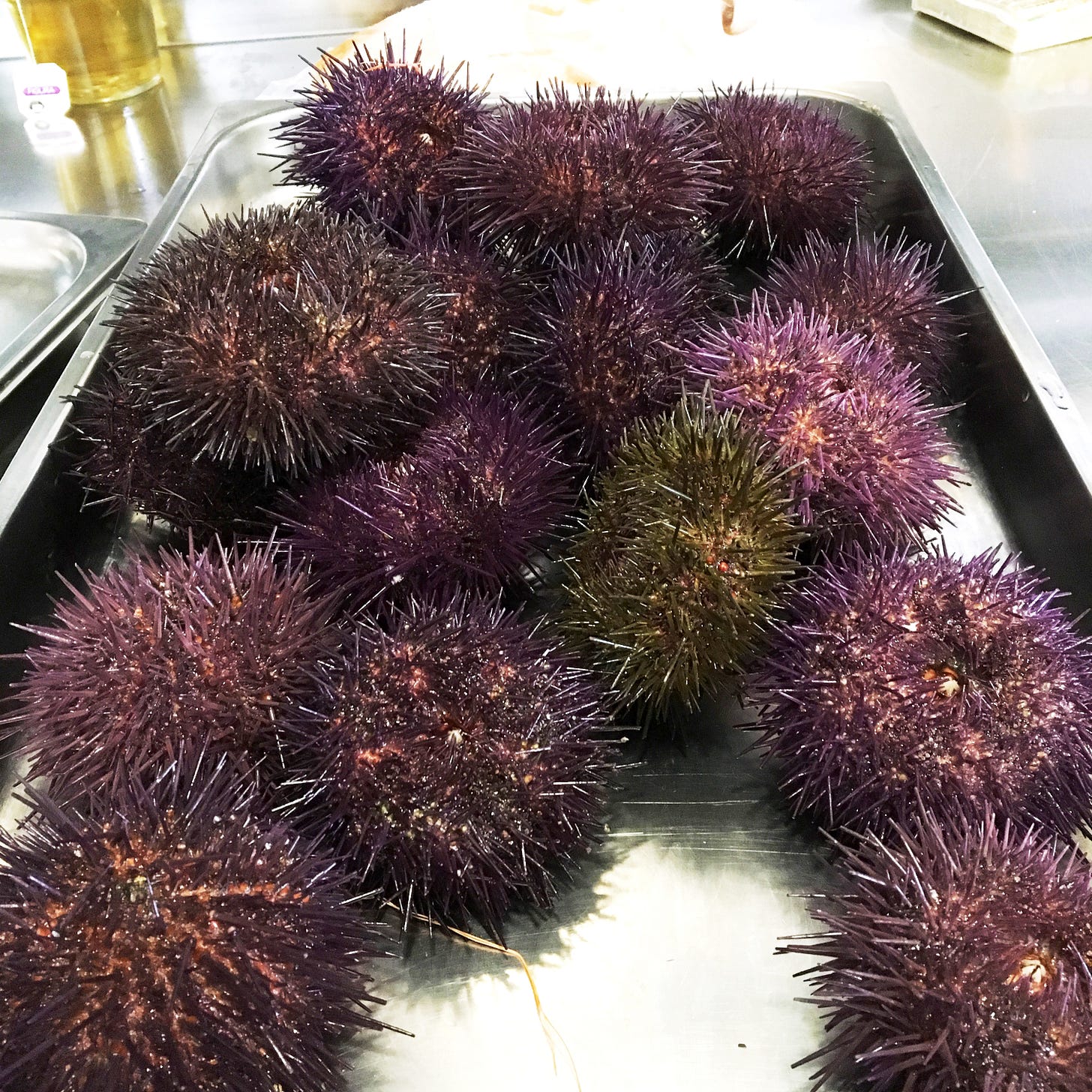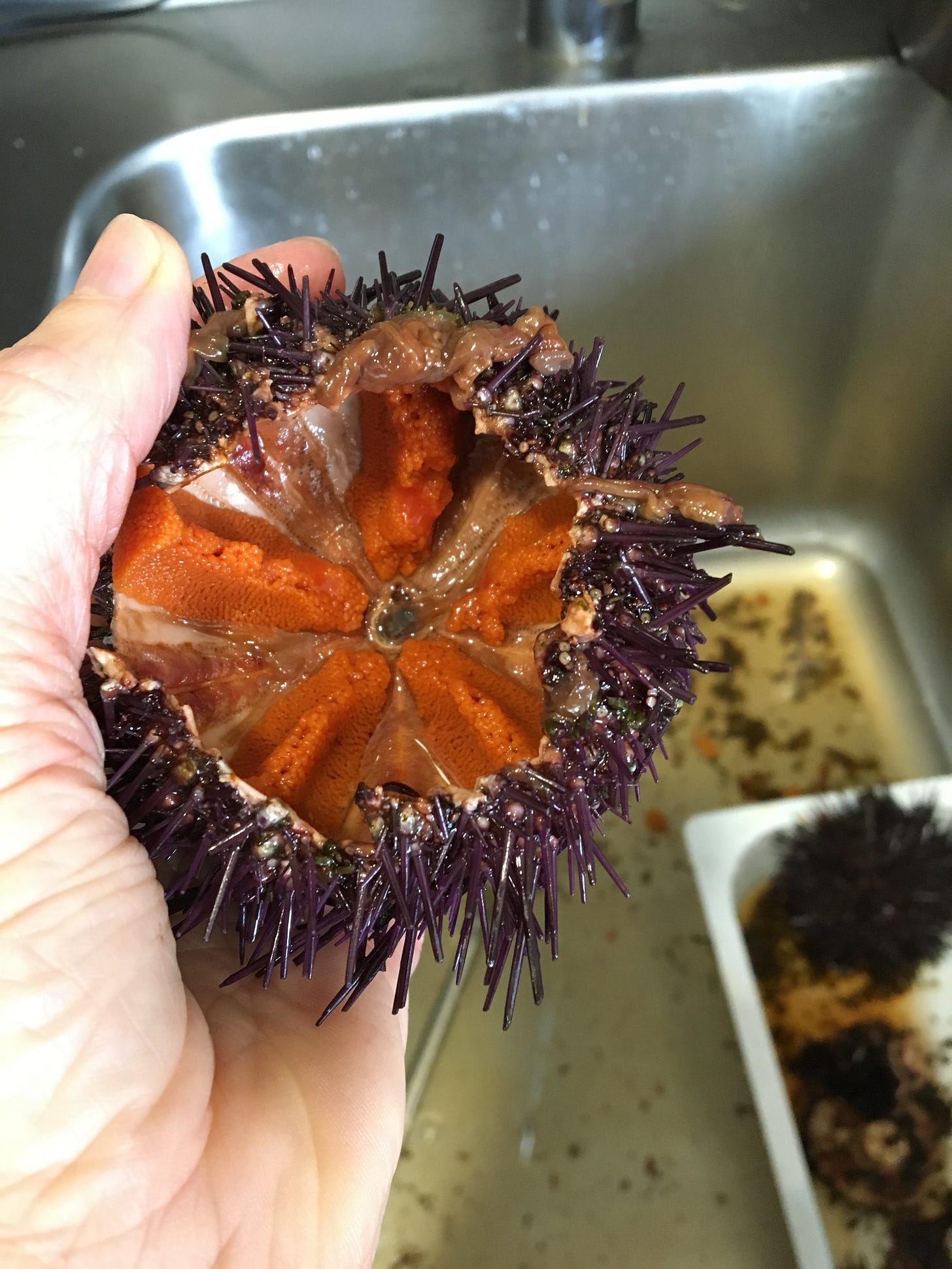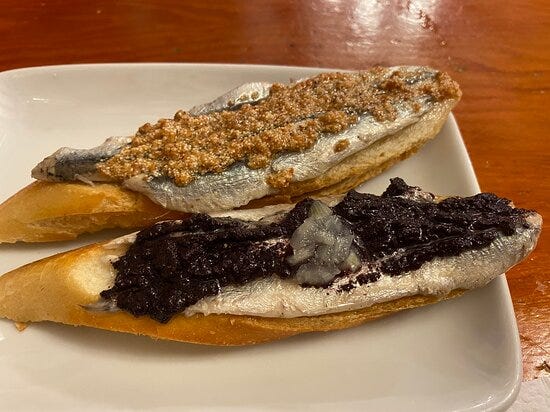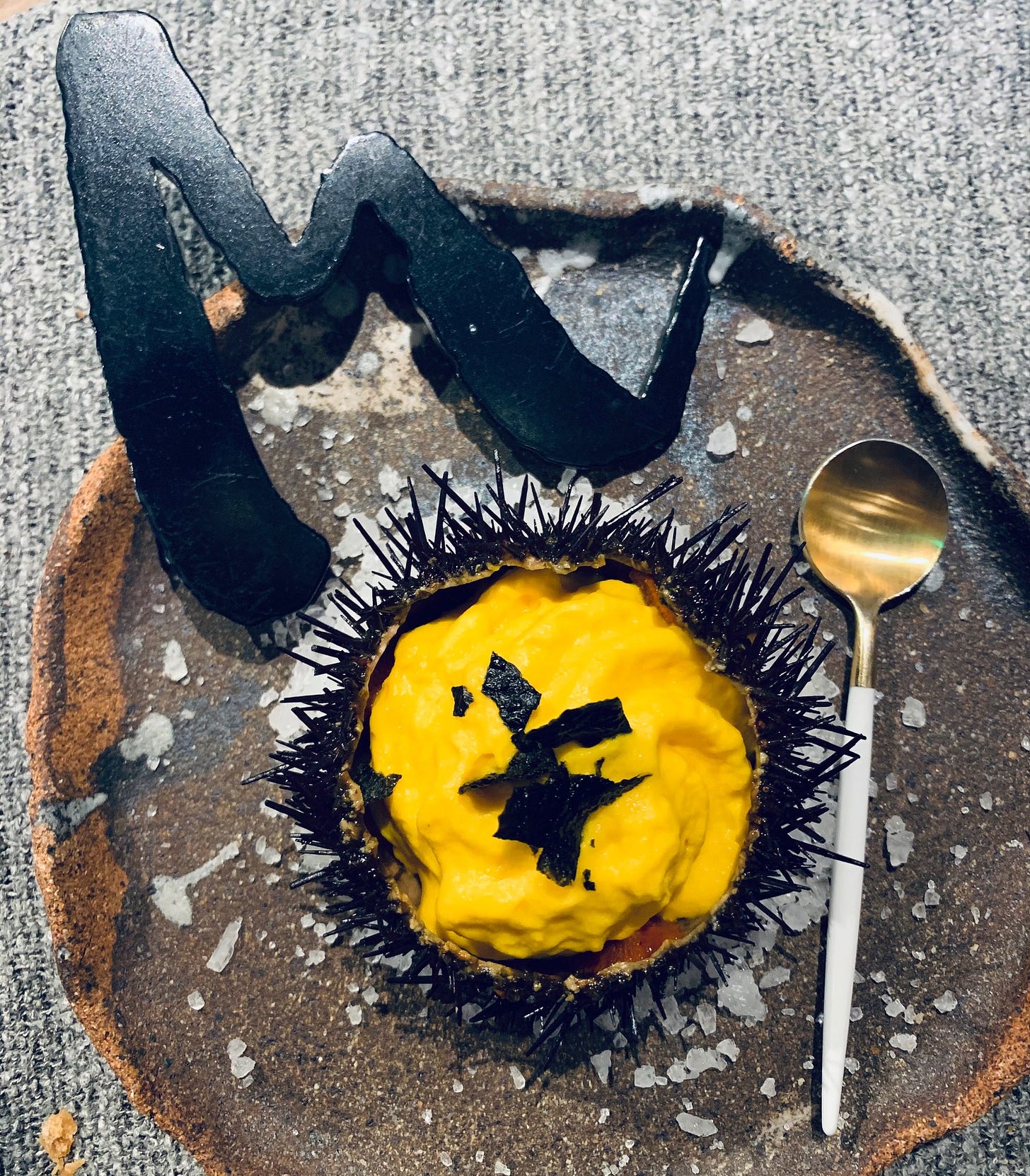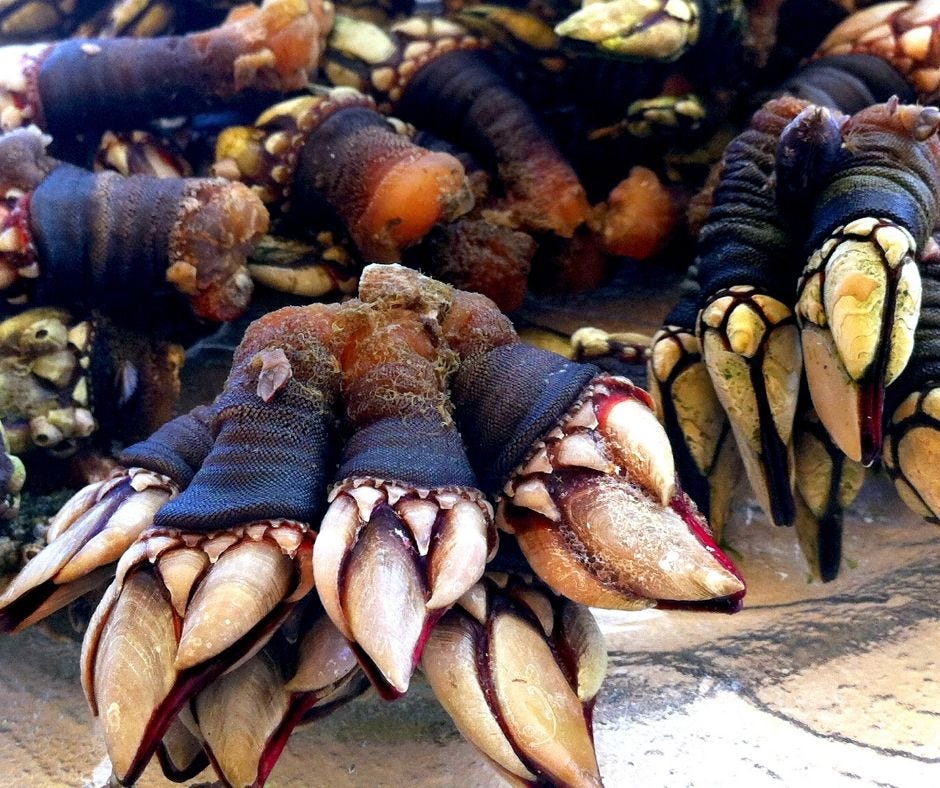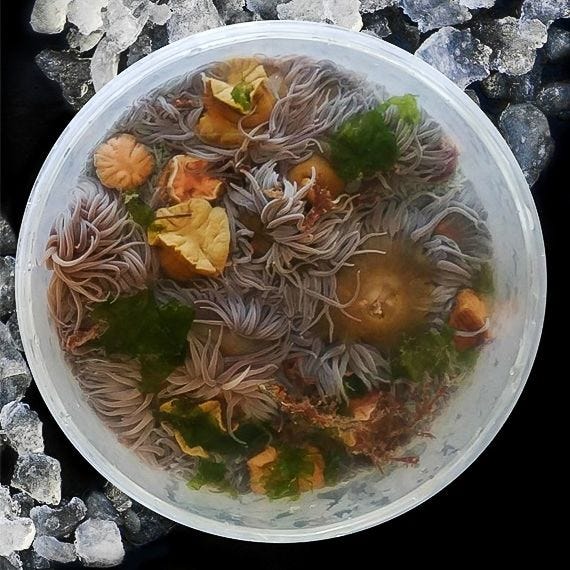Day 6: The Weird and Wonderful
I get to prep a box of sea urchins as the tv cameras roll.
I enter the kitchen later today and I’m surprised to see TV cameras rolling. I creep around the back of the pass to get to my workspace.
A surprise awaits me
When I get there, I see a large polystyrene box. I lift the lid.
Sea Urchins! It’s packed full of spiky black sea urchins.
I look closer and see they are not just black, but a range of colours from a shimmery purple black, to a sea-green black, to a rusty-red.
I feel a smile grow on my face, a smile that quickly turns into a what the? How the hell do I open these?
“I’ll show you how to do one. But then I’ve got to go and do something, OK?” says Marcos.
He gloves up.
“Don’t be too gentle with them or they’ll spike you,” Marcos tell me, “Hold them firmly like this and dig the scissors into the side.”
I watch as he cuts out a circle on the underside of the sea urchin, then runs it under the tap to clean out the black gunk and grit.
As he cleans, the five roe appear radiating outwards like a bright, orange star.
And with that, Marcos disappears leaving me with the scissors and a box of shimmering sea urchins.
I’m on Day 6 of a Chef Stage at El Monastrell, a Michelin one-star that overlooks Alicante’s port and specialises in sea-food, with langoustine and gamba roja regulars on their menu.
You can read about how I got into this cheffing lark if you have a few minutes to spare. But safe to say, so far so good.
I’m enjoying it immensely and I can’t help getting amazed by ingredients like this.
With Marcos gone, it is time I get going.
I pick up the first sea urchin and turn it over so its spike poke down into palm of my hand, I take hold of the scissors …. and it’s right then when I sense them.
There is a huge tv camera over my shoulder.
The tv crew who are doing a report on El Monstrell’s owner Maria Jose San Roman have decided to get some footage of the chefs at work.
Oh Christ! Should I tell them this is my first go at opening one of these?
The cameraman nods at me, urging me to continue.
Well, I think to myself, it’s not like they are going to use the footage, it will just be cut.
And I dig the scissors into the sea urchin.
One of the black spike flies off, and I sense the camera man take a small step backwards.
Too right. These are painful buggers. The last time I saw one of these, it was stuck in my toe, on a holiday in Malta.
Sea urchins live amongst the rocks, in the shallows, where the waves lap at the shore and just where the uninitiated try to exit the sea.
Many countries will pay a hefty price for them.
In Japan, sea urchin is known as uni, and its roe can retail for as much as ¥40,000 ($360) per kg. Here, in Spain they are prized in Galicia and the Basque Country.
Somehow I get through my debut sea-urchin-opening without blinding the camera man, although he does move on to the pastry section fairly quickly which is fine by me, as I have a box of these to get through before 11am.
I find my rhythm and begin to lay the beautiful orange roe on the white greaseproof paper.
Will I ever do this at home? Will you? Unlikely. And so, why learn a technique you will never use? Why eat something new? Why not just stick to the tried and tested.
I guess for me, this is all about experimenting and discovery.
Different ingredients are like different ideas; they broaden horizons and expand the possibilities.
By experimenting with these weird and wonderful ingredients we discover something unknown.
We open up our choices. And even, in the end, if you choose not to choose it, isn’t it better to have had the choice?
And if you do ever get the chance to eat one, I urge you to take the plunge.
For those who haven’t tasted a sea urchin before, it is like an intense hit of a sea. Salty. Creamy. Soft. It takes you somewhere quite new.
A taste you can’t forget.
As I cut and wash and lay the bright orange roes out on a tray, my mind drifts back to a summer spent in the the Basque seaside town of San Sebastian. It’s where I tried sea urchin for the first time.
After training, my Basque friends had taken me to a bar called Txepetxa, in the Old Town.
Here, the sea urchin roe is placed on top of a pickled anchovy. Boom! The wave hits you, then laps around in your mouth leaving salt and seaweed and for a second you are out in the Bay of Biscay getting blown around in a force 9 storm, before you return to find you are sat on a wooden chair in a bar.
Txepetxa, San Sebastian
Txepetxa, a pintxo bar in San Sebastian’s Old Town has been around since 1973. The menu is dedicated to pickled and cured anchovies with toppings. It is well worth trying them all. Amongst the specialities spider crab, olive tapenade and of course sea urchin.
Montoro, Alicante
Or if you are in Alicante then Montoro, a fine dining restaurant, a few kilometres out of Alicante centre is well worth making the journey to visit. Reservations are difficult to come by, often selling out within the day they open the bookings. If you do get a table try the sea urchin with salsa de naranja, a sweet orange sauce.
Anyway I digress…
Back in the kitchen, I take the final sea urchin out of the box. The last roe is scooped out, and the trays placed in the blast-chiller. Later, they will be brought out just before service, topped with lettuce foam and a flower.
We say goodbye to the tv crew and I though that would be the last I’d hear of it but it turns out they did use the footage of me opening a sea urchin on the programme!
A few months later I bumped into a friend on the street who had seen me on tv.
“I saw you on tv the other day. You were in a kitchen,” my friend told me.
“What?” I asked my mind flashing back to the sea urchin day. “Oh, was I by the sink?”
“Yes, you were by the sink,” replied my friend.
“Oh my god, that was the first time I’d ever done that. What did you think?”
“Errr…I thought you were washing up.”
Want to join me on this journey?
For the next 100 Days I’m staging in Spanish Michelin star restaurants. In the next episode, things get hot. I learn how to cook Rabbit and Snail paella. You get the recipe!
If you want to join me for the next episode, add your name to the list.
So, are you convinced? Will you be ordering erizo de mar on your next trip to Spain? What about gooseneck barnacles, or ortiguillas-de-mar?
When you’re ready to push out beyond croquetas and paellas here are a few of my favourite (and not so favourite) weird and wonderfuls.
I can’t say I like them all.
But I can say they are worth trying.
Here are three more to push the boundaries.
And definitely, do try those sea urchins.
Percebes (Gooseneck Barnacles)
Exactly! My thoughts too. When these first appeared in my life at my Spanish niece’s communion they were piled high on silver platters. A real treat, apparently. The family dived in with gusto.
They look like something from Jurassic Park and taste as if you were sucking on a rock covered in green slimy seaweed you’ve just got out of the sea. But actually, once over the mental obstacles, they are quite tasty. Unusual. But yes, tasty.
My verdict: Yes, but takes some acquiring.
Ortiguillas de mar (Sea anemone)
At the restaurant, these blue and green sea anemones arrive in salt water. They are then dusted in flour then deep fried for two minutes. They taste intensely of the sea but are soft, gelatinous inside.
My verdict: Oh yes. Definitely. My new favourite find.
Callos (Tripe)
One of my jobs this week has been to wash and blanche the tripe. Not my favourite part of the day. It is then cooked for hours along with chorizo, morcilla, pigs trotters and vegetables to create an intense stew that the Spanish chefs rave about.
My verdict: A taste I am politely still acquiring, although I must admit I have stopped trying to acquire it. :-)
A cooking course in your inbox each week!
Join me, Nicola Fairbrother as I stage for 100 days in a professional kitchens in Spain.
Personal stories of life in a professional kitchen.
Read this one to get an idea of what you can expect.
Plus recipes and culinary techniques from Spain's best restaurants.
Visual tutorials designed to help you absorb the whole process quickly and easily.
Here’s an example.
Improve your cooking skills with Olympian in a Kitchen.





